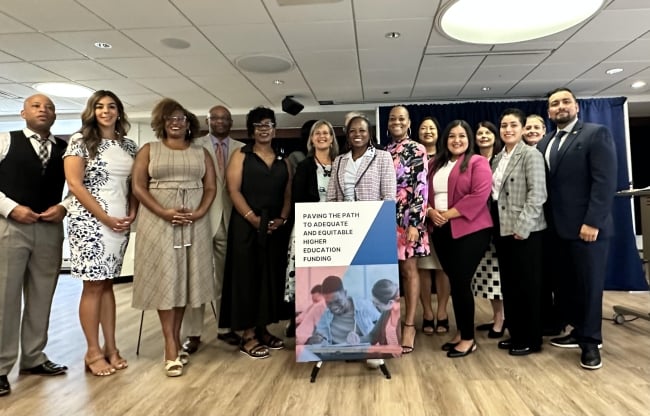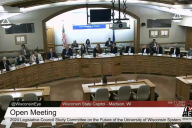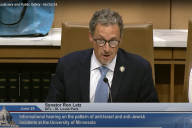You have /5 articles left.
Sign up for a free account or log in.

Illinois Senate majority leader Kimberly Lightford and Representative Carol Ammons announced Senate Bill 3965 at a Tuesday press conference in Chicago.
Partnership for College Completion
Four months ago, a commission of Illinois higher education officials and bipartisan lawmakers unveiled their proposal for an ambitious new funding model that prioritizes adequate and equitable allocations for the state’s colleges and universities. Now, despite predictions that it could take years to advance, the state’s majority Democrats have formalized the proposal and introduced a bill in preparation for next year’s legislative session.
Senate majority leader Kimberly Lightford and Representative Carol Ammons announced Senate Bill 3965, titled the Adequate and Equitable Funding Formula for Public Universities Bill, on Tuesday. Drafted to make college more accessible for Illinois students by increasing state funding to prevent tuition hikes and filling funding gaps between flagships and regional institutions, the bill would be one of the first of its kind in the nation if it ultimately passes.
“Numerous challenges prevent a student from reaching the commencement stage or even pursuing a college education. Some of these challenges are in the state’s control, and it’s time to address them,” Lightford said at a press conference introducing the bill. “Higher ed is alive with 3965!” she and her fellow supporters later chanted with gusto. No Republican lawmakers were present.
The legislation is framed around the recommendations released by the Commission on Equitable University Funding in March. Lobbyists, commission members and outside higher education scholars say the bill closely follows language from the commission’s report.
The legislation, like the report, was designed to mimic a growing number of revamped K-12 funding models, including Illinois’s own, which remediate years of underfunding for schools with lower property tax revenue but higher need for student support. The bill takes a parallel approach for higher ed by outlining a formula that accounts not only for the size of institutions and the types of academic programs they offer, but also demographic factors such as socioeconomic, racial and geographic diversity. Inclusion of the latter variables would particularly benefit minority-serving institutions.
Combined, these variables will be used to calculate adequacy targets, or the optimal amount of annual funding each institution needs to fully serve its students. That will be compared with a resource profile, or how much money the institution is expected to contribute to meet its target, and the difference between the two would be called the adequacy gap.
But closing that gap for all of the state’s institutions would require a hefty $1.4 billion in additional appropriations over the next 10 to 15 years. The bill calls for a target of $135 million of additional funds to be appropriated annually for the next 10 years.
Stakeholders on all sides are thrilled to see this novel funding bill on the floor, but some are skeptical—or cautiously optimistic at best—that the complex idea will ever come to practical fruition.
Making Compromises
Although key elements of the new legislation comport with the commission’s report, there were several issues that even the commission had yet to reach an agreement on. Those gaps are currently filled with placeholders in the bill—taken from the report—that lawmakers expect will be contested.
Key topics up for debate include how to factor in various graduate programs, endowments and the amount of tuition revenue colleges should be expected to contribute—as well as the timeline for increasing state funding to close the adequacy gap.
Ralph Martire, executive director of the Center for Tax and Budget Accountability, a nonpartisan Illinois think tank, said the bill’s introduction kicks off a series of educational events and feedback sessions across the state to gauge public opinion and build bipartisan support before the legislative session begins in January.
“In that process,” he said, “what will at least partially be identified is which of these placeholders, if any, will actually have to be addressed before the legislation passes. Some of them may not.”
Still, he expects the bill to move forward. “I don’t think, ultimately, progress on passing the legislation will be impeded,” he added. “I mean, this is groundbreaking legislation. This does something that, frankly, no other state does … So you’re gonna have to overcome that. But I think that’s easy to overcome in the educational process.”
Discussions began immediately after Lightford and Ammons’s press conference with a roundtable of stakeholders held by Advance Illinois, an independent education policy and advocacy organization.
Between the intensely polarized political climate nationwide, the local tensions over a dip in state revenue and the sheer number of stakeholders—each lobbying the interests of their own institution—it would seem that passing such a groundbreaking bill is an uphill climb. But the bill’s sponsors are hopeful.
“Everything that we do in Springfield is a compromise. That’s the nature of the business,” Ammons said. “We are losing our students to other universities, and we have underfunded our university system for two decades. Those facts cannot be changed. The question is whether the General Assembly finds this as an appropriate investment in education.
“We believe that we will make this case. The data is on our side,” she added.
Lisa Castillo Richmond, executive director of the Partnership for College Completion, an Illinois-based equity group that helped write the bill, sees its introduction, even if it includes issues that are still to be ironed out, as a step forward.
“I’m not naïve. I know that it’s going to be very challenging in a budget environment where there are so many things that our state wants to do to improve the quality of life for all Illinois,” she said. “But this is a critical piece of that. And I think we will be able to make the case for that.”
Will It Work?
But doubts remain—and not just about whether the bill can be passed. Jennifer Ann Delaney, a former professor at the University of Illinois at Urbana-Champaign who is now an education professor at the University of California, Berkeley, is among those who have concerns about the complexity of the formula, particularly a lack of clarity on contributions expected from students through tuition in a metric known as equitable student share.
In recent years, droves of Illinois high school graduates have left the state for cheaper tuition elsewhere. A key goal of the bill is to shift the responsibility of paying for college to the government, instead of leaving the burden on students. Delaney is skeptical that will happen.
“My sense, at a 30,000-foot view, is that the bill codifies the notion that wealthy individuals are being expected to subsidize low-income individuals,” she said. “It’s like a Robin Hood notion that wealthy individuals will be expected to pay more, to then subsidize low-income individuals and institutions. It’s not to say that that hasn’t been happening at institutions, but as a state policy, that is something different.”
She also fears that at a time when the state budget faces shortfalls, it will be difficult to gather the funding necessary to close the adequacy gap between institutions, especially when the bill includes a “hold harmless” provision that ensures funding is not going to be taken away from the flagship and R-1 institutions to invest into regionals.
Delaney explained that “if there isn’t new money there” in a particular year, “the hold harmless kicks in and then there’s no change.”
“It’s saying we’ll put a new funding formula on, but we don’t want to hurt institutions, as they are prior to the formula,” she said. “For political reasons, moving forward with hold harmless made it easier to get institutions to agree to have a funding formula. But in practice, what it’s going to mean is that this formula may come in, and very little may happen.”
But Delaney noted that doubting the soundness of the bill is different from doubting its ability to pass.
“My instinct would say they wouldn’t file for a bill unless they felt confident that they could move it forward,” she said.
Remaining Optimistic
Institutional leaders, however, seem to be optimistic, saying that the challenges and compromises will be worth it to ensure increased, more predictable funding and a better student retention rate.
“There’s a shared understanding that we need a rational, adequate, equitable funding formula,” said Lisa Freeman, president of Northern Illinois University and a member of the commission. “Even the universities who had strong suggestions for change in the bill are going forward optimistically, believing that their ideas will have a fair hearing.”
José L. García, a spokesperson for the Illinois Board of Higher Education, said the new formula would complement investments made in recent years.
“Since 2019, Governor J. B. Pritzker and the General Assembly have made historic investments in higher education, including increased investment in university operating funds by $212 million (20 percent) and increased funding for [state-funded, need-based grants] by $310 million (77 percent),” he said. “We look forward to working with legislators as they continue to evaluate the Commission’s report and advance efforts that adequately, equitably and stably fund the state’s public universities.”
The University of Illinois system, whose three institutions include the one least likely to benefit from the model’s equity adjustments (the flagship Urbana-Champaign campus), has previously said it’s “fully on board” with the new model. However, when asked about the new bill, Nicholas Jones, executive vice president, declined to comment, saying the system had not had enough time to thoroughly evaluate its language and provisions.
But Freeman and Jorge Arteaga, the Midwest program manager for Young Invincibles, a think tank that advocates for young adults, are cautiously optimistic that the bill will be passed in some form by the end of the legislative session next spring.
“Our goal from the start has been to try to see this happen as soon as we can,” Arteaga said. “But for now we’re at a time where we’re hitting the ground running, and we’re all just excited to be here and have this be at the center point of the conversation.”








